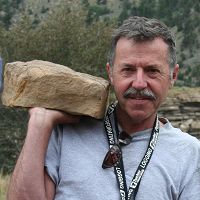Zhang et al., 2015
Water-regolith-energy Interaction in Landscape Evolution and Its Influence on Forming Asymmetric Landscape: An Example from the Shale Hills Critical Zone Observatory of Central Pennsylvania
Zhang, Yu, Rudy L Slingerland, Yuning Shi, Christopher Duffy and Nicole West (2015)
EP33D-06 Landscape Evolution from a Critical Zone Science Perspective II, presented at 2015 Fall Meeting, AGU, San Francisco, CA, 14-18 Dec.
-
Calhoun, Christina, Shale Hills, COLLABORATOR
-
Shale Hills, INVESTIGATOR
-
Shale Hills, INVESTIGATOR
-
Shale Hills, INVESTIGATOR
-
Shale Hills, INVESTIGATOR, COLLABORATOR
Abstract
Shale Hills Critical Zone Observatory (SSHCZO) is a 0.08 km2 first order experimental research catchment with relatively homogeneous bedrock, regolith and tectonic uplift, but with an asymmetric slope and thickness of regolith on the north- and south-facing hillslopes. In this paper, we use a hydrological-morphodynamic model (LE-PIHM), which links bedrock, soil, surface and subsurface water flow, plant, energy, and seasonal climate, to address the influence of water-regolith-energy interaction on soil creep process, the possible factors causing slope asymmetry and the spatial distribution of regolith transport at the SSHCZO. Two non-dimensional parameters were used to explore the competitive relationship between regolith diffusion and advection forming self-organized channel spacing, relief and slope length at steady state. Model simulation under seasonal meteorological forcing shows spatial variations of hillslope sediment fluxes. An experimental study using Beryllium 10 at the SSHCZO (West et al 2013) showed that a south-facing planar slope had a greater diffusion flux rate than a planar on north-facing slope. The model confirms this relationship in general although there are significant local variations. The largest regolith transport rate by overland flow (advection) occurs at the junctions of main channel and swales. The model simulation further suggests that north-south differences in diffusive flux may be a result of asymmetric solar insolation which affects freeze-thaw frequency and sediment transport through the process of soil creep. This study demonstrates the value of physically-based distributed landscape evolution model on estimating spatial distribution of regolith transport and highlights the critical transition zone.
Citation
Zhang, Yu, Rudy L Slingerland, Yuning Shi, Christopher Duffy and Nicole West (2015): Water-regolith-energy Interaction in Landscape Evolution and Its Influence on Forming Asymmetric Landscape: An Example from the Shale Hills Critical Zone Observatory of Central Pennsylvania. EP33D-06 Landscape Evolution from a Critical Zone Science Perspective II, presented at 2015 Fall Meeting, AGU, San Francisco, CA, 14-18 Dec..
 This Paper/Book acknowledges NSF CZO grant support.
This Paper/Book acknowledges NSF CZO grant support.
Explore Further





